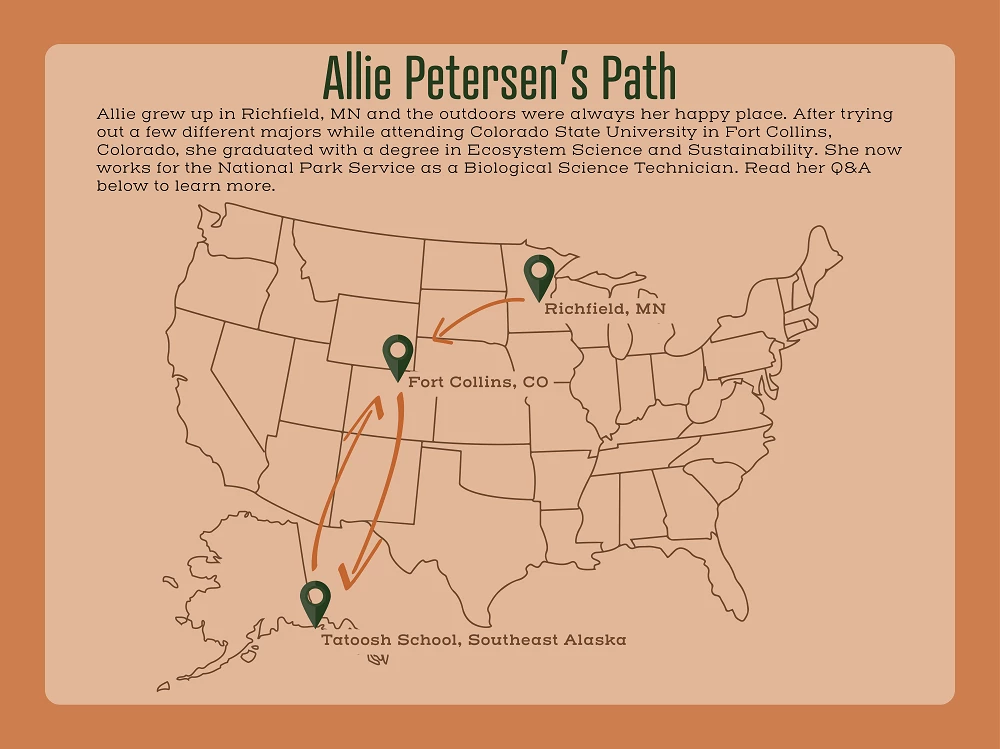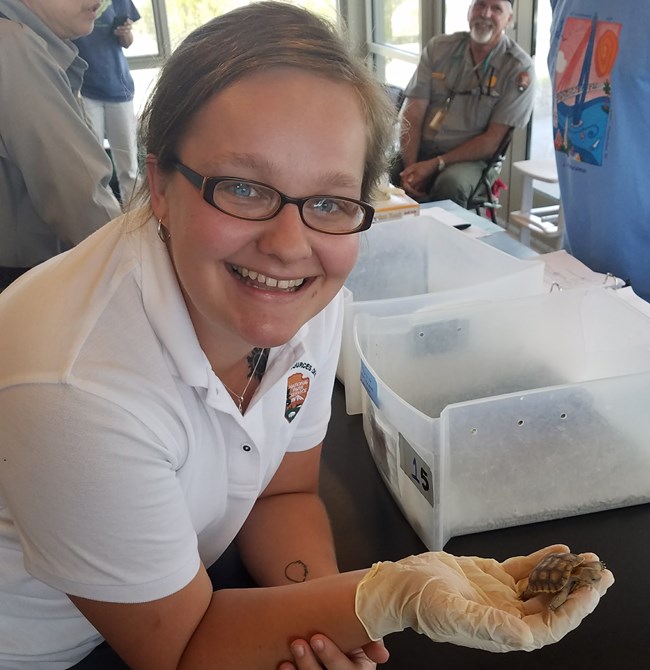Article
Allie Petersen's Path

Created by N.Anderson
Allie grew up in Richfield, Minnesota and the outdoors were always her happy place. After trying out a few different majors while attending Colorado State University in Fort Collins, Colorado, she graduated with a degree in Ecosystem Science and Sustainability. She now works for the National Park Service as a Biological Science Technician with the Biological Resources Division. Read her Q&A below to learn more.
Map of the United States. Pins are dropped in Richfield, Minnesota, Fort Collins, Colorado and Southeast Alaska. Arrows connect the pins in order of her journey.

Image courtesy of Allie Petersen
A Q&A with Allie Petersen
Tell us a little about your current job at the NPS.
I am a Biological Science Technician with the Science Division of the National Park Service (NPS), working primarily with the Wildlife Health Branch (WHB). I’m sort of the go-to for all of the WHB needs. I help coordinate the NPS Veterinary Diagnostic Service and am the go- between for the Colorado State University (CSU) Veterinary Diagnostic Laboratory and NPS staff. I also facilitate our Institutional Animal Care and Use Committee (IACUC), which oversees animal welfare in research projects happening across the service. Those are my two “big buckets.” Additionally, I assist with data management, database stuff, quality assurance/quality control, really just anything the wildlife branch needs. Every day is different, which is really great.
What was the journey like to get here? Was it a straight path or did you try a few different things?
I grew up in Minnesota and my family was always really into camping and being outside. I remember appreciating nature as a kid, doing things like digging up worms with my brother, picking blueberries, and swimming in Lake Superior. My mom was an Earth Science teacher and the outdoors was always my happy place. I always liked science, but in high school I had a couple of really great teachers who inspired me to ask questions and be curious, which gave me the support I needed to stay interested in science.
I originally wanted to be a marine biologist and go to school in California, but most of those schools were too far away and too competitive. I went to Colorado State University (CSU) and was on a pre-veterinary track until I realized that I didn’t want to be a vet as much as other people did. I didn’t want school to be my whole life for the next 8 years. I wanted to find a balance between school and life where I could still be outside and enjoy social time, but still wanted to use my science brain. I tried biology and also environmental health, but organic chemistry really was not my thing and none of the internships available in those majors really interested me. They are important, but just not what I wanted to do.
At the end of my sophomore year, I switched to Ecosystem Science and Sustainability in the Warner College of Natural Resources (WCNR). All WCNR students got to do a field learning experience and I found a program that allowed me to spend 6 weeks kayaking around Southeast Alaska and living on the beach — all while learning about natural resource management, fisheries, and forestry. That trip and the change in major was a huge turning point! It was going to take a bit longer to finish school, but this program was actually interesting to me. The major was all about how everything interacted with each other. All of those connections were so cool to me and with the small class sizes, I was able to find my people who loved to nerd out about trees with me.
I graduated from CSU in December of 2015. I had an internship set up for my last semester, but it didn’t turn out to be what I was looking for. I respectfully bowed out of that and utilized some of my connections to land a volunteer position working with the National Parks Service on engaging the public with the iNaturalist app. After graduation, that position offered me an internship with Geoscientists in Parks (GIP) working on NPS centennial materials and iNaturalist. That next summer, the Wildlife Health Branch asked me to intern with them. I was thrilled and stayed with WHB as an intern and contractor for 4 years. After working through different partnerships in order to stay working with the park service, I was finally hired as a full-fledged federal employee in November 2019! It was a pretty difficult process, but I had many mentors helping me and coaching me along.
What was the most important thing in getting you to where you are today?
To boil it down, it would be the people: my high school Biology teacher, my college professors, my first supervisor, Kelly Coy, and Tracy Thompson, who was like another mom to me. It’s all about the people. I had encouragers and mentors all along the way that told me to have a strong voice for what I wanted and shared my passions.
Do you have any tips for those who are still in college or just graduating about how to find your path?
My advice is just to put yourself out there. Cold calling or emailing around, making connections, and asking if someone need volunteers or interns — they are all a great way to get your foot in the door. You may not get paid at first, but that is how natural resources works sometimes. Be persistent and figure out what you want and take chances to get there. Surround yourself with people who will help you get there, whether that is personally or professionally. Oh, and of course, always ask questions and don’t be afraid to admit that maybe you don’t know something but are curious to learn more.
Goals for the future?
I really want to get my boots on the ground doing wildlife work in a park and in the field. I am making connections so hopefully in a few years when I want to go to a park, they will have worked with me and know me.
